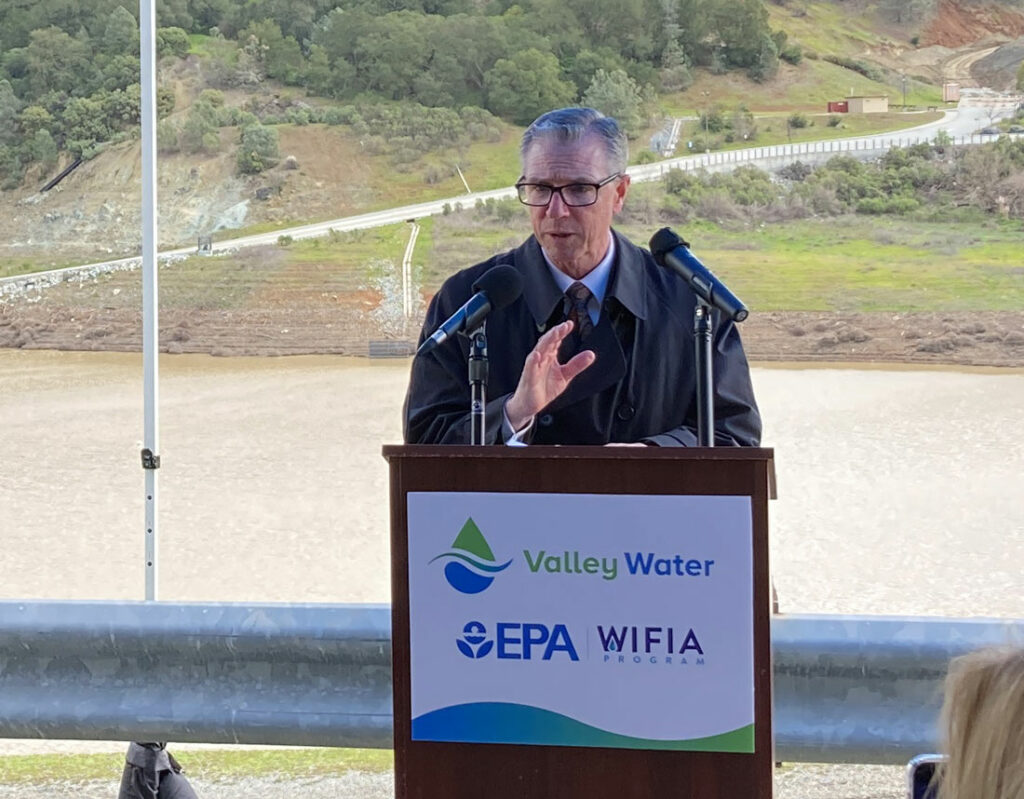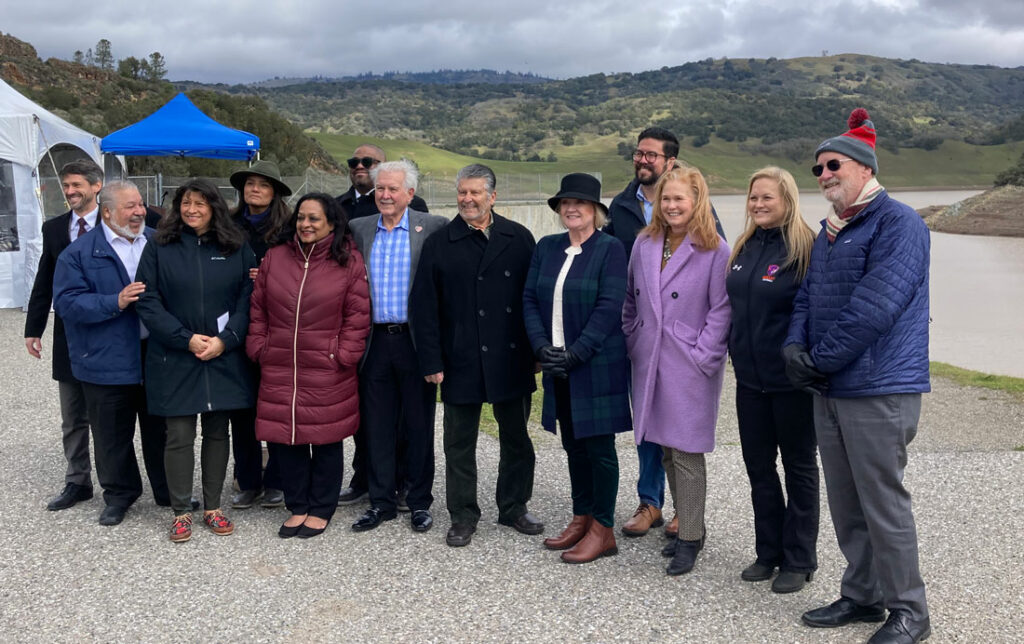
With a cold winter storm bearing down on Morgan Hill, U.S. Environmental Protection Agency administrators joined local and regional representatives Feb. 23 at the top of Anderson Dam to announce the availability of $727 million in low-cost loans that will fund the rebuilding of the dam and other projects.
The loans for Valley Water, the water district that serves Santa Clara County, come from the EPA’s Water Infrastructure Finance and Innovation Act (WIFIA). Of the total $727 million, $580 million will go toward the Anderson Dam Seismic Retrofit Project—the total cost of which has ballooned to more than $1.2 billion since it was initially planned more than 10 years ago.
A total of $147 million of the WIFIA loans will go toward a bundle of the district’s “Safe, Clean Water Projects,” including the Coyote Creek Flood Protection Project, according to Valley Water staff.
Officials at a Feb. 23 press conference atop Anderson Dam, next to the reservoir’s spillway in east Morgan Hill, said these projects provide environmental justice benefits, such as flood protection for disadvantaged communities and improved reliability of local water supply.
Valley Water Board of Directors Chair John Varela said the EPA loans will not only help complete the Anderson Dam project, but will keep water rates lower and end up saving money for the district, taxpayers and water rate payers.
“These low-cost WIFIA loans will allow Valley Water to finance major projects like the replacement of the dam that we’re standing on today in a cost-efficient manner,” Varela said as cold, gusty winds blew across the crest of the dam. “Thanks to the EPA and the WIFIA program, these loans are projected to save Valley Water $256 million over the life of the loans.”
Varela added that the Anderson Dam Seismic Retrofit Project, when complete, “will help ensure the public safety, protect regional water supply and provide environmental benefits for generations to come.”
The funds announced Feb. 23 marked the 100th loan provided by the WIFIA program—a milestone touted by EPA administrators.
EPA Assistant Administrator Radhika Fox said in six years, WIFIA’s 100 loans have provided about $17 billion to communities throughout the country. Collectively, these loans have generated about $5 billion in savings for water rate payers and 123,000 jobs.
“That means there are 50 million Americans around this country that have better drinking water infrastructure, better wastewater infrastructure and better stormwater infrastructure because of this program,” Fox said.
The Anderson Dam Seismic Retrofit Project is being constructed in multiple phases. In November, crews began building a 1,750-foot-long, 20-foot diameter diversion tunnel from the bottom of the dam into the floor of Anderson Reservoir. The tunnel is designed to allow the district to release much larger volumes of water from the reservoir in case of emergencies.
The tunnel is expected to be complete by 2024 at the earliest. After that, crews will begin rebuilding a new earthen Anderson Dam embankment. That construction is currently scheduled to last from late 2024 to 2032, according to Valley Water.
The Anderson Dam Seismic Retrofit Project became necessary after state authorities in 2009 determined that Anderson Dam would not withstand a major earthquake, and the crest of the dam could slump in such an event—leaving Morgan Hill underwater within minutes.
Although the district drained Anderson Reservoir to about 3% capacity late last year to accommodate the tunnel construction—and for safety reasons—the rainy winter has filled the water body to about 35% as of Feb. 24.
Morgan Hill Mayor Mark Turner, also speaking at the Feb. 23 press conference, thanked the EPA and more than a dozen state, regional and federal representatives in attendance.
But he also called attention to the “extended timeline and endless delays” in the Anderson Dam project since it was initially planned in 2009. Such delays could end up reducing the value of funds like the WIFIA loans as project construction and planning costs continue to climb.
Turner noted that Assemblymember Robert Rivas introduced legislation in 2020 that would have expedited projects like the Anderson Dam retrofit, but the bill was vetoed by Gov. Gavin Newsom.
“What’s most important is the action we take to ensure the money is used to the fullest extent to help the residents of Santa Clara County,” Turner said at the press conference. “Delays equal dollars, and we cannot allow undue delays on critical projects to squander the opportunities that this $727 million…would allow.”

Another major project that will benefit from the EPA loans is Valley Water’s Coyote Creek Flood Protection Project. Officials noted that the Feb. 23 press conference occurred almost exactly six years after the President’s Day flooding of Coyote Creek in 2017. That incident displaced thousands of residents in San Jose and resulted in more than $100 million in property damages.
The Coyote Creek Flood Protection Project—which will be designed to prevent such disasters—is currently in the design phase, with a “pre-construction and update” meeting scheduled for the public in May, according to Valley Water.
“Once completed, our efforts to install new flood walls, passive barriers and berms along Coyote Creek will protect homes, businesses and highways in historically flood-prone neighborhoods, so it’s a really great project and long overdue,” Valley Water Director Barbara Keegan said at the Feb. 23 press conference.

Also speaking at the Feb. 23 press conference were Valley Water CEO Rick Callender, EPA Administrator Martha Guzman, State Water Resources Control Board Chair E. Joaquin Esquivel, State Senator for District 17 John Laird, 28th District Assemblymember Gail Pellerin, Santa Clara County Supervisor Cindy Chavez and San Jose Mayor Matt Mahan.
Callender said Valley Water went through a rigorous competitive process to apply for and acquire the WIFIA loans from the EPA. He added that the $727 million in funding will be “immensely helpful” in getting the designated projects completed because the loans provide money in the bank that can be used immediately for planning, design and construction.














